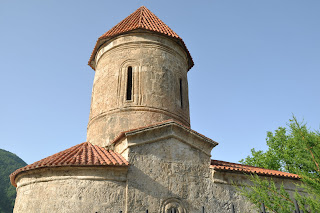So Wednesday was spent travelling out to the regions again. We took the old Soviet train again, arriving in Seki early Wednesday morning. There we jumped into a cab and headed to Kish, a tiny village just outside of Seki. There we visted an old Albanian Church that was recently restored and turned into a small museum with the help of NHE. It is an Albanian Church not like the country Albania, but because much of Azerbaijan used to be called Albania in the Middle Ages.

After looking around the Church, we had tea and breakfast with the lady who looks after the place, getting to taste a variety of traditional Azeri jams, all of which are very sweet (people in Azerbaijan really enjoy their sweets, at all hours of the day). From there we went back to Seki to meet with some producers and pick up a sign we had made for the store. While in Seki I was able to visit the Khan's Palace, which was built in the 18th century by the ruling family of Seki. It was very beautiful, with detailed carvings and paintings adorning the walls and ceilings.

After that, we took a taxi to the village of Nic, a tiny Udi village in the countryside about an hour from Seki. There we visited and were treated to dinner by a local family who will be producing some jam for the store soon. The village and its history is pretty unique, as the Udi people have their own language and culture. Unfortunately, during the Soviet era much of this unique culture slowly dissipated, leaving behind a village and people barley distinguishable from their Azeri neighbors. In recent years however, there have been a number of projects, including many run by NHE, to help reclaim and restore the identity and language of the Udi people.


this is not Albanian church, this is orthodox Georgian church of middle ages
ReplyDeleteAccording to a local tradition, Christianity entered Caucasian Albania in the 1st century through St. Elisæus of Albania, a disciple of St. Thaddeus of Edessa. St. Elisæus was ordained bishop by James the Just in Jerusalem, and travelled eastward through Persia to preach Christianity in the land of the Maskout, one of the Caucasian Albanian tribes (hypothetically related to the ancient Massagetae of Central Asia).[10] From there he travelled to Utiķ, to the city of Saharn, but was chased from there by the pagans. After this he arrived at a place called Gis where he built a church - the first in the Caucasus,[11][12] today commonly believed to be the Church of Kish north of Shaki, Azerbaijan. The church founded by St. Elisæus was regarded by Caucasian Albanians as their "mother-church" that laid the foundation of institutionalised Christianity in the kingdom.[2][11]
ReplyDeleteOn his way through the Zerguni Valley, St. Elisæus was martyred, and his remains were buried in a place named Homenķ. They were later exhumed and reburied in the Jrvshtik Monastery (in the present-day Tartar Rayon, Azerbaijan)